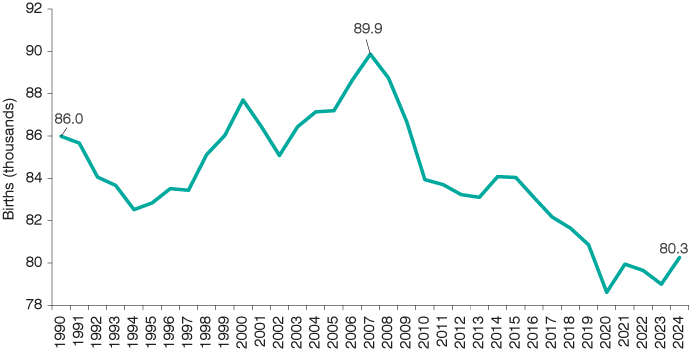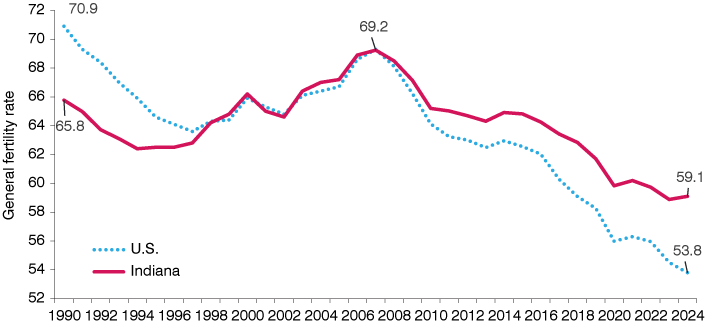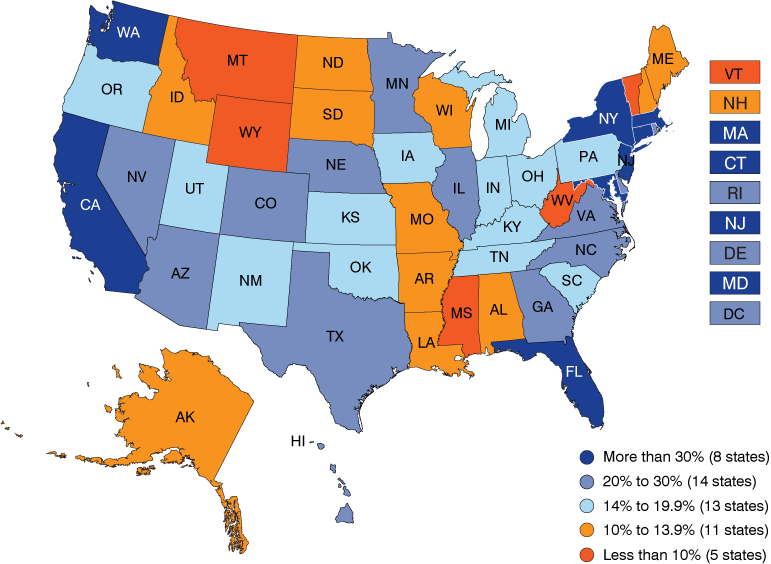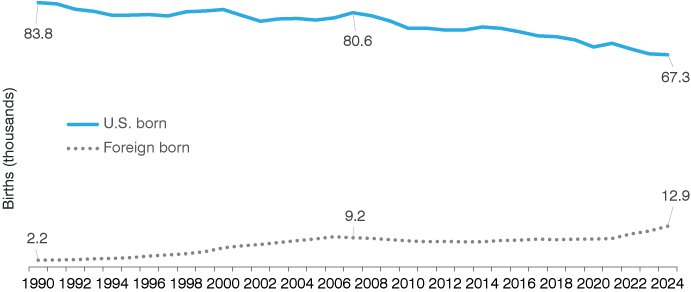Indiana sees uptick in births in 2024

The share of Indiana’s total births that have been to foreign-born mothers has increased from 3% in 1990 to 16% in 2024.
Indiana recorded 80,257 births in 2024.
This is a 1.6% increase over the previous year and the state’s highest annual tally since 2019. Indiana’s growth rate last year ranked 17th among states and far outpaced the nation’s 0.9% increase.
While this uptick is welcome news, the fact remains that Indiana has experienced a dramatic decline in fertility since the Great Recession, with the number of births in the state declining nearly 11% since 2007 (see Figure 1). Furthermore, 2024 ranks as the state’s 8th-lowest annual birth total since 1946.
Figure 1: Indiana’s annual births

Source: U.S. Centers for Disease Control and Prevention
This trend is not unique to Indiana. The U.S. and Indiana had roughly identical fertility rates in 2007, but since that point, the nation’s 22% decline in this measure has been a much steeper slide than Indiana’s 15% drop over the same period (see Figure 2). In fact, Indiana has fared better than most of its peers, with its change in fertility rate over the last 17 years ranking as the 5th-smallest decline among states.
Figure 2: Annual fertility rates for the U.S. and Indiana

Note: General fertility rate refers to the number of births per 1,000 women ages 15 to 44.
Source: U.S. Centers for Disease Control and Prevention
Immigration fueled Indiana’s increase in births
Indiana’s total increase of 1,257 births between 2023 and 2024 was driven exclusively by a growing number of births to foreign-born mothers in the state. As Figure 3 shows, Indiana saw an increase of roughly 1,540 births to foreign-born mothers last year, while births to U.S.-born mothers dropped by more than 180.
Figure 3: Indiana births by mother’s nativity

Source: U.S. Centers for Disease Control and Prevention
Looking at the period between 2021 and 2024, during which Indiana saw a post-pandemic immigration boom, births to foreign-born mothers in the state climbed by more than 3,920 — a 43% increase. Meanwhile, births to U.S.-born mothers fell by more than 3,530 over this same stretch.
As a result of these divergent trends, births to foreign-born mothers accounted for more than 16% of the Indiana total in 2024, up from 11% just three years earlier. Nationally, 24% of all births in the U.S. last year were to foreign-born mothers.
New Jersey had the nation’s highest share of total births to foreign-born mothers in 2024 at 38.3%, followed by Massachusetts (37.7%), Florida (36.7%) and New York (36.2%). Indiana’s share ranked 27th among states last year (see Figure 4).
Figure 4: Births to foreign-born mothers as a share of total births, 2024

Source: U.S. Centers for Disease Control and Prevention
Long-term trend
For Indiana, this recent uptick in births to foreign-born mothers marks another significant turning point in this measure. The number of births in Indiana to foreign-born mothers increased each year between 1990 and 2006, climbing from 2,152 births at the beginning of this stretch to 9,617 by the end. During this period, the state saw the strongest gains between 1999 and 2006 when births to foreign-born mothers grew by an average of nearly 680 per year.
Indiana experienced an abrupt reversal to this trend as the Great Recession hit in 2007, with births to foreign-born mothers falling by an average of roughly 320 per year over the next five years. The state saw only modest growth over the following decade before the post-pandemic immigration boom led to an average increase of more than 1,300 births to foreign-born women per year between 2022 and 2024.
Meanwhile, the number of births to U.S.-born women in Indiana has been falling since 1990, with the pace of this decline only accelerating as time has gone on (see Figure 5). Between 1991 and 2007, for instance, births to U.S.-born mothers in the state fell by an average of nearly 190 per year. Over the next eight years, this measure then fell by roughly 620 births per year. Finally, since 2016, births to U.S.-born mothers in Indiana have declined by nearly 930 per year.
Figure 5: Indiana births by mother’s nativity

Note: In this graphic, births to “U.S.-born mothers” also include any births where the mother’s nativity is unknown or not stated. For reference, 0.3% of Indiana births between 2016 and 2024 have had this designation.
Source: Indiana Business Research Center, using data from the Annie E. Casey Foundation, the Indiana Department of Health and the U.S. Centers for Disease Control and Prevention
Conclusion
All told, the share of Indiana’s total births that have been to foreign-born mothers has increased from 3% in 1990 to 16% in 2024. Immigrant mothers accounted for nearly all of Indiana’s growth in annual births between the mid-1990s and the start of the Great Recession in 2007 and have helped to slow the pace of decline since.
From declining school enrollments to the potential for a shrinking labor force to mounting fiscal challenges at all levels of government, Indiana’s falling birth counts will have far-reaching implications for the state.1 Of course, this situation is not unique to Indiana, but is playing out across the country. If Indiana and the U.S. are to see any meaningful rebound in its fertility trends, immigration must almost certainly play a role.
Notes
- Matt Kinghorn, “Indiana’s school-age population projected to decline,” InContext, September-October 2024, https://www.incontext.indiana.edu/2024/sept-oct/article2.asp.
